Managing Change and Motivating Employees: A Case Study of EMTA
VerifiedAdded on 2023/06/08
|9
|2106
|154
AI Summary
This report analyzes the barriers to and enablers of change within EMTA, the leadership and management styles used by the Executive Director and the Office Manager, and the effect of potential staff cuts on staff demotivation. It also suggests ways to manage change effectively and motivate employees.
Contribute Materials
Your contribution can guide someone’s learning journey. Share your
documents today.
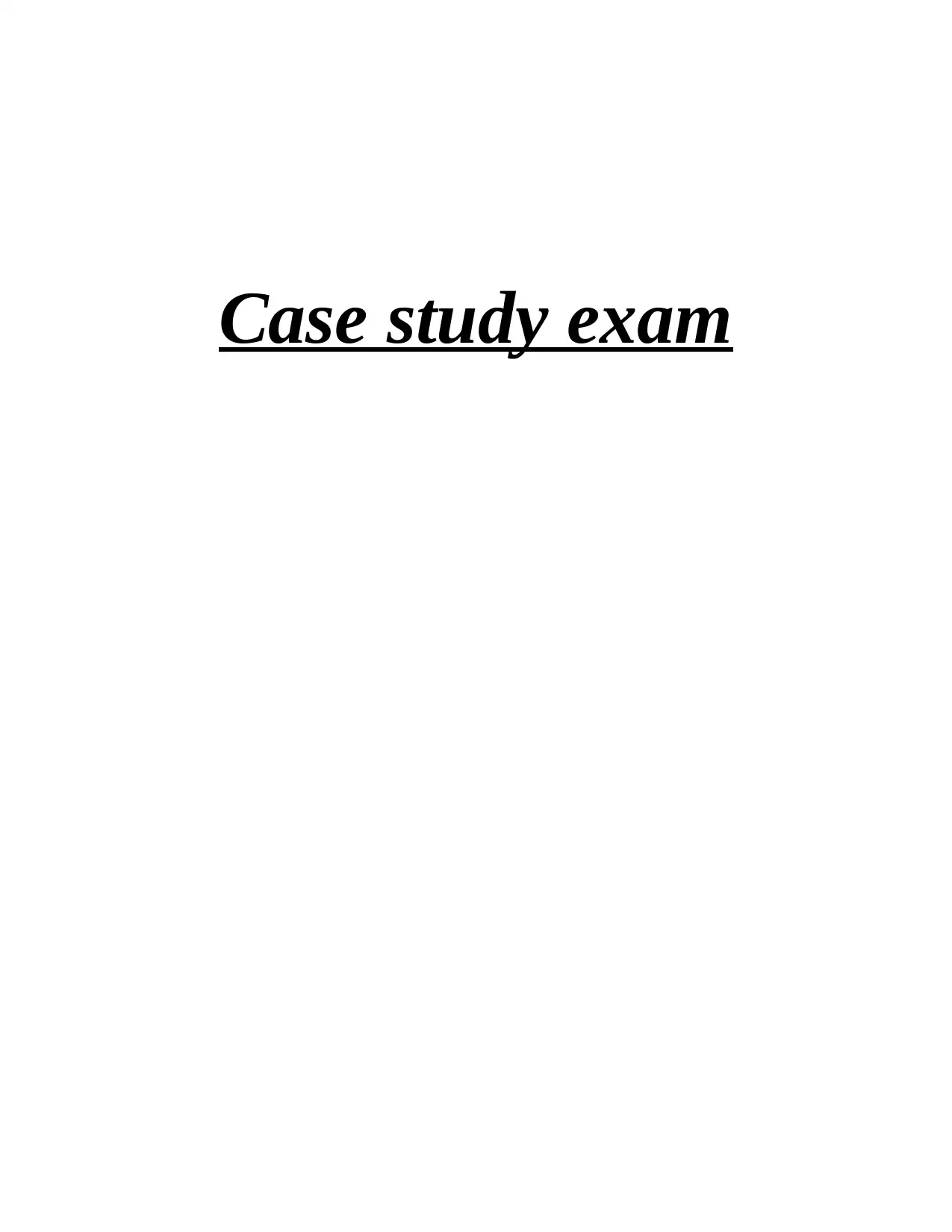
Case study exam
Secure Best Marks with AI Grader
Need help grading? Try our AI Grader for instant feedback on your assignments.
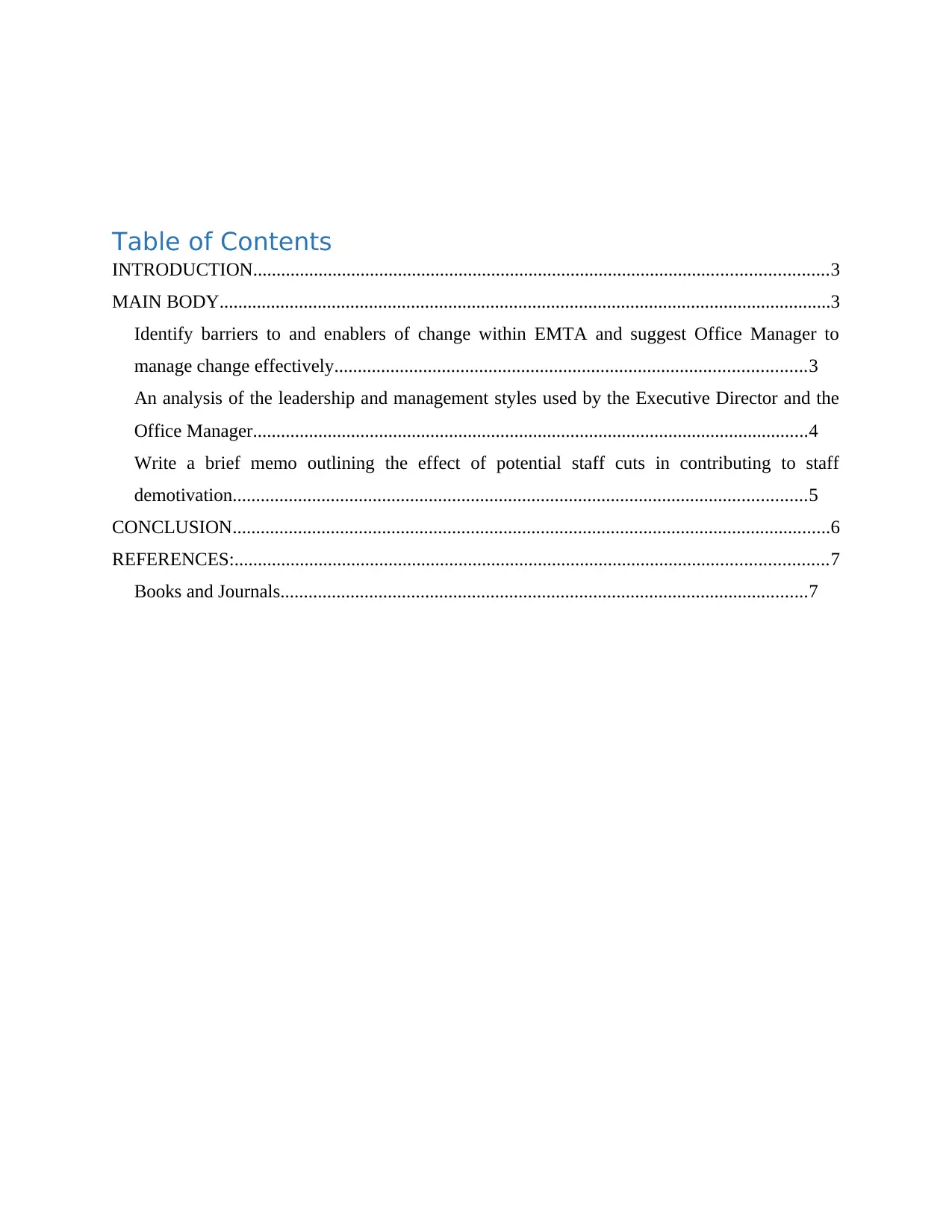
Table of Contents
INTRODUCTION...........................................................................................................................3
MAIN BODY...................................................................................................................................3
Identify barriers to and enablers of change within EMTA and suggest Office Manager to
manage change effectively.....................................................................................................3
An analysis of the leadership and management styles used by the Executive Director and the
Office Manager.......................................................................................................................4
Write a brief memo outlining the effect of potential staff cuts in contributing to staff
demotivation...........................................................................................................................5
CONCLUSION................................................................................................................................6
REFERENCES:...............................................................................................................................7
Books and Journals.................................................................................................................7
INTRODUCTION...........................................................................................................................3
MAIN BODY...................................................................................................................................3
Identify barriers to and enablers of change within EMTA and suggest Office Manager to
manage change effectively.....................................................................................................3
An analysis of the leadership and management styles used by the Executive Director and the
Office Manager.......................................................................................................................4
Write a brief memo outlining the effect of potential staff cuts in contributing to staff
demotivation...........................................................................................................................5
CONCLUSION................................................................................................................................6
REFERENCES:...............................................................................................................................7
Books and Journals.................................................................................................................7
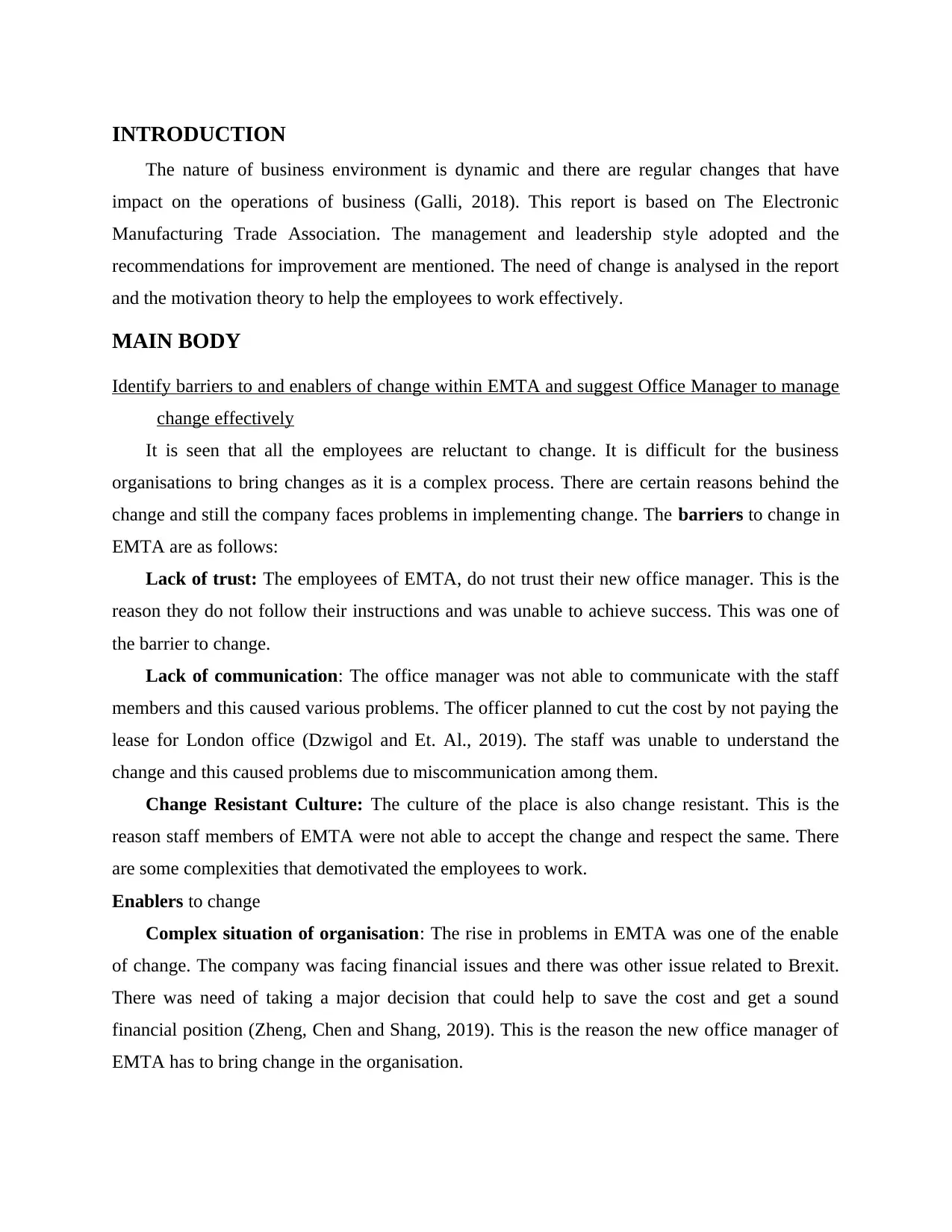
INTRODUCTION
The nature of business environment is dynamic and there are regular changes that have
impact on the operations of business (Galli, 2018). This report is based on The Electronic
Manufacturing Trade Association. The management and leadership style adopted and the
recommendations for improvement are mentioned. The need of change is analysed in the report
and the motivation theory to help the employees to work effectively.
MAIN BODY
Identify barriers to and enablers of change within EMTA and suggest Office Manager to manage
change effectively
It is seen that all the employees are reluctant to change. It is difficult for the business
organisations to bring changes as it is a complex process. There are certain reasons behind the
change and still the company faces problems in implementing change. The barriers to change in
EMTA are as follows:
Lack of trust: The employees of EMTA, do not trust their new office manager. This is the
reason they do not follow their instructions and was unable to achieve success. This was one of
the barrier to change.
Lack of communication: The office manager was not able to communicate with the staff
members and this caused various problems. The officer planned to cut the cost by not paying the
lease for London office (Dzwigol and Et. Al., 2019). The staff was unable to understand the
change and this caused problems due to miscommunication among them.
Change Resistant Culture: The culture of the place is also change resistant. This is the
reason staff members of EMTA were not able to accept the change and respect the same. There
are some complexities that demotivated the employees to work.
Enablers to change
Complex situation of organisation: The rise in problems in EMTA was one of the enable
of change. The company was facing financial issues and there was other issue related to Brexit.
There was need of taking a major decision that could help to save the cost and get a sound
financial position (Zheng, Chen and Shang, 2019). This is the reason the new office manager of
EMTA has to bring change in the organisation.
The nature of business environment is dynamic and there are regular changes that have
impact on the operations of business (Galli, 2018). This report is based on The Electronic
Manufacturing Trade Association. The management and leadership style adopted and the
recommendations for improvement are mentioned. The need of change is analysed in the report
and the motivation theory to help the employees to work effectively.
MAIN BODY
Identify barriers to and enablers of change within EMTA and suggest Office Manager to manage
change effectively
It is seen that all the employees are reluctant to change. It is difficult for the business
organisations to bring changes as it is a complex process. There are certain reasons behind the
change and still the company faces problems in implementing change. The barriers to change in
EMTA are as follows:
Lack of trust: The employees of EMTA, do not trust their new office manager. This is the
reason they do not follow their instructions and was unable to achieve success. This was one of
the barrier to change.
Lack of communication: The office manager was not able to communicate with the staff
members and this caused various problems. The officer planned to cut the cost by not paying the
lease for London office (Dzwigol and Et. Al., 2019). The staff was unable to understand the
change and this caused problems due to miscommunication among them.
Change Resistant Culture: The culture of the place is also change resistant. This is the
reason staff members of EMTA were not able to accept the change and respect the same. There
are some complexities that demotivated the employees to work.
Enablers to change
Complex situation of organisation: The rise in problems in EMTA was one of the enable
of change. The company was facing financial issues and there was other issue related to Brexit.
There was need of taking a major decision that could help to save the cost and get a sound
financial position (Zheng, Chen and Shang, 2019). This is the reason the new office manager of
EMTA has to bring change in the organisation.
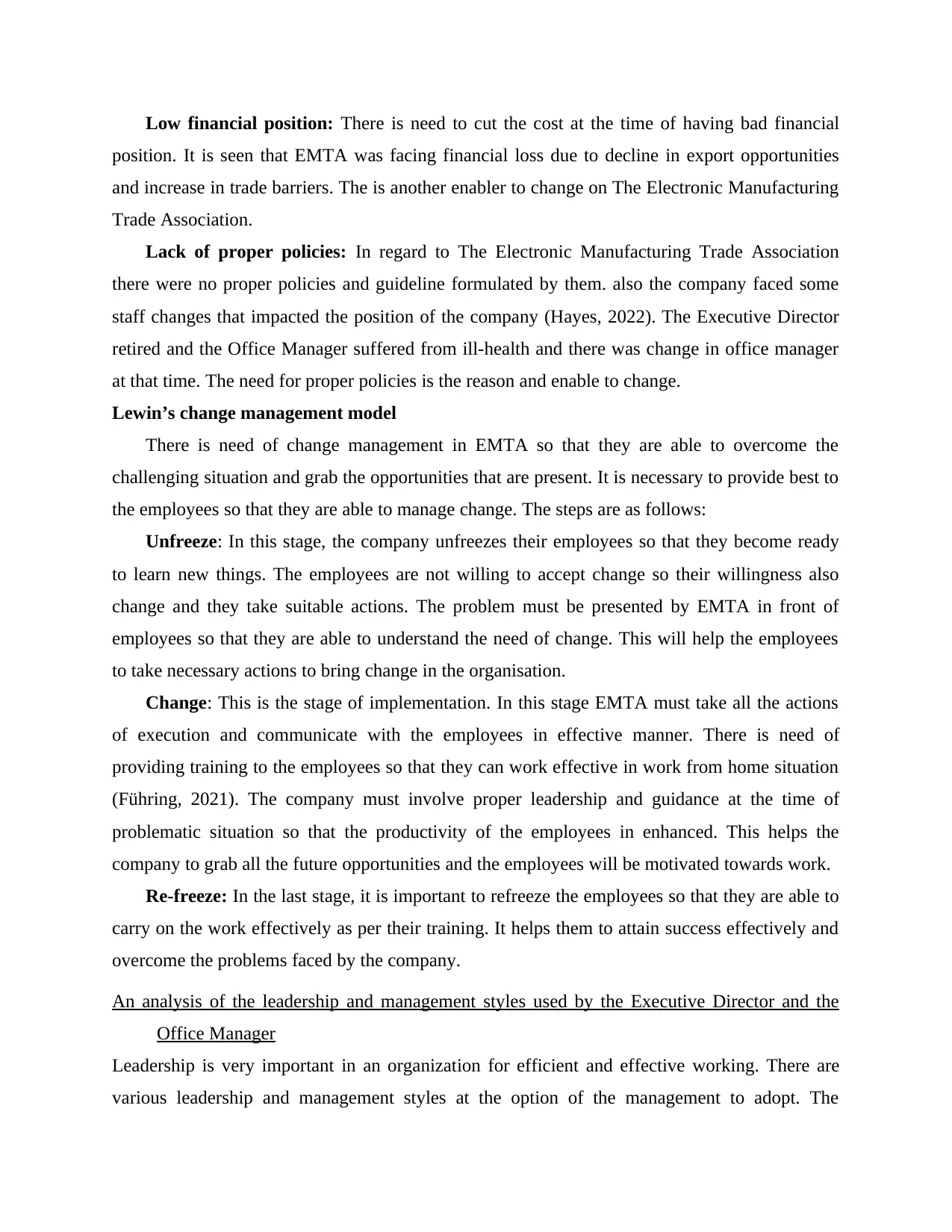
Low financial position: There is need to cut the cost at the time of having bad financial
position. It is seen that EMTA was facing financial loss due to decline in export opportunities
and increase in trade barriers. The is another enabler to change on The Electronic Manufacturing
Trade Association.
Lack of proper policies: In regard to The Electronic Manufacturing Trade Association
there were no proper policies and guideline formulated by them. also the company faced some
staff changes that impacted the position of the company (Hayes, 2022). The Executive Director
retired and the Office Manager suffered from ill-health and there was change in office manager
at that time. The need for proper policies is the reason and enable to change.
Lewin’s change management model
There is need of change management in EMTA so that they are able to overcome the
challenging situation and grab the opportunities that are present. It is necessary to provide best to
the employees so that they are able to manage change. The steps are as follows:
Unfreeze: In this stage, the company unfreezes their employees so that they become ready
to learn new things. The employees are not willing to accept change so their willingness also
change and they take suitable actions. The problem must be presented by EMTA in front of
employees so that they are able to understand the need of change. This will help the employees
to take necessary actions to bring change in the organisation.
Change: This is the stage of implementation. In this stage EMTA must take all the actions
of execution and communicate with the employees in effective manner. There is need of
providing training to the employees so that they can work effective in work from home situation
(Führing, 2021). The company must involve proper leadership and guidance at the time of
problematic situation so that the productivity of the employees in enhanced. This helps the
company to grab all the future opportunities and the employees will be motivated towards work.
Re-freeze: In the last stage, it is important to refreeze the employees so that they are able to
carry on the work effectively as per their training. It helps them to attain success effectively and
overcome the problems faced by the company.
An analysis of the leadership and management styles used by the Executive Director and the
Office Manager
Leadership is very important in an organization for efficient and effective working. There are
various leadership and management styles at the option of the management to adopt. The
position. It is seen that EMTA was facing financial loss due to decline in export opportunities
and increase in trade barriers. The is another enabler to change on The Electronic Manufacturing
Trade Association.
Lack of proper policies: In regard to The Electronic Manufacturing Trade Association
there were no proper policies and guideline formulated by them. also the company faced some
staff changes that impacted the position of the company (Hayes, 2022). The Executive Director
retired and the Office Manager suffered from ill-health and there was change in office manager
at that time. The need for proper policies is the reason and enable to change.
Lewin’s change management model
There is need of change management in EMTA so that they are able to overcome the
challenging situation and grab the opportunities that are present. It is necessary to provide best to
the employees so that they are able to manage change. The steps are as follows:
Unfreeze: In this stage, the company unfreezes their employees so that they become ready
to learn new things. The employees are not willing to accept change so their willingness also
change and they take suitable actions. The problem must be presented by EMTA in front of
employees so that they are able to understand the need of change. This will help the employees
to take necessary actions to bring change in the organisation.
Change: This is the stage of implementation. In this stage EMTA must take all the actions
of execution and communicate with the employees in effective manner. There is need of
providing training to the employees so that they can work effective in work from home situation
(Führing, 2021). The company must involve proper leadership and guidance at the time of
problematic situation so that the productivity of the employees in enhanced. This helps the
company to grab all the future opportunities and the employees will be motivated towards work.
Re-freeze: In the last stage, it is important to refreeze the employees so that they are able to
carry on the work effectively as per their training. It helps them to attain success effectively and
overcome the problems faced by the company.
An analysis of the leadership and management styles used by the Executive Director and the
Office Manager
Leadership is very important in an organization for efficient and effective working. There are
various leadership and management styles at the option of the management to adopt. The
Secure Best Marks with AI Grader
Need help grading? Try our AI Grader for instant feedback on your assignments.
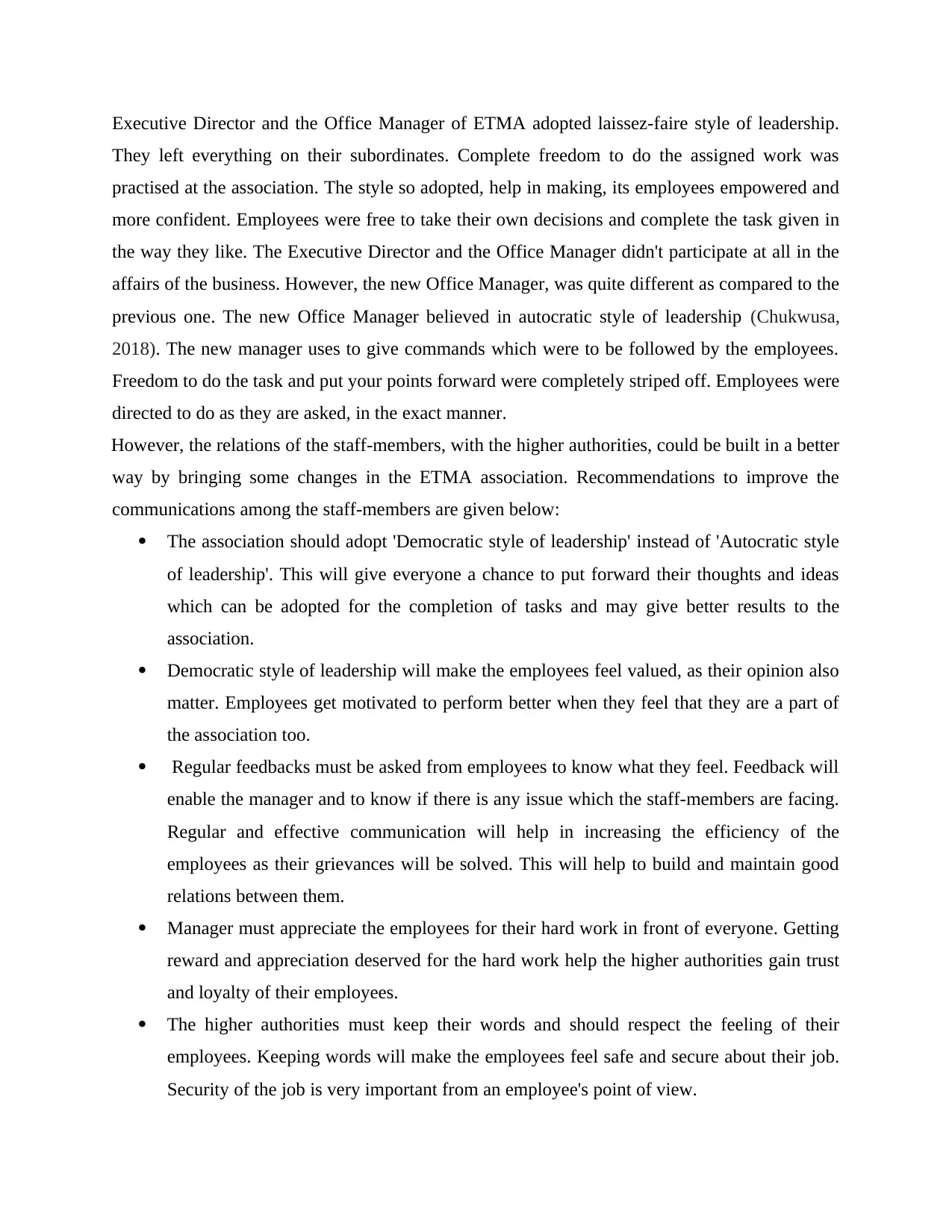
Executive Director and the Office Manager of ETMA adopted laissez-faire style of leadership.
They left everything on their subordinates. Complete freedom to do the assigned work was
practised at the association. The style so adopted, help in making, its employees empowered and
more confident. Employees were free to take their own decisions and complete the task given in
the way they like. The Executive Director and the Office Manager didn't participate at all in the
affairs of the business. However, the new Office Manager, was quite different as compared to the
previous one. The new Office Manager believed in autocratic style of leadership (Chukwusa,
2018). The new manager uses to give commands which were to be followed by the employees.
Freedom to do the task and put your points forward were completely striped off. Employees were
directed to do as they are asked, in the exact manner.
However, the relations of the staff-members, with the higher authorities, could be built in a better
way by bringing some changes in the ETMA association. Recommendations to improve the
communications among the staff-members are given below:
The association should adopt 'Democratic style of leadership' instead of 'Autocratic style
of leadership'. This will give everyone a chance to put forward their thoughts and ideas
which can be adopted for the completion of tasks and may give better results to the
association.
Democratic style of leadership will make the employees feel valued, as their opinion also
matter. Employees get motivated to perform better when they feel that they are a part of
the association too.
Regular feedbacks must be asked from employees to know what they feel. Feedback will
enable the manager and to know if there is any issue which the staff-members are facing.
Regular and effective communication will help in increasing the efficiency of the
employees as their grievances will be solved. This will help to build and maintain good
relations between them.
Manager must appreciate the employees for their hard work in front of everyone. Getting
reward and appreciation deserved for the hard work help the higher authorities gain trust
and loyalty of their employees.
The higher authorities must keep their words and should respect the feeling of their
employees. Keeping words will make the employees feel safe and secure about their job.
Security of the job is very important from an employee's point of view.
They left everything on their subordinates. Complete freedom to do the assigned work was
practised at the association. The style so adopted, help in making, its employees empowered and
more confident. Employees were free to take their own decisions and complete the task given in
the way they like. The Executive Director and the Office Manager didn't participate at all in the
affairs of the business. However, the new Office Manager, was quite different as compared to the
previous one. The new Office Manager believed in autocratic style of leadership (Chukwusa,
2018). The new manager uses to give commands which were to be followed by the employees.
Freedom to do the task and put your points forward were completely striped off. Employees were
directed to do as they are asked, in the exact manner.
However, the relations of the staff-members, with the higher authorities, could be built in a better
way by bringing some changes in the ETMA association. Recommendations to improve the
communications among the staff-members are given below:
The association should adopt 'Democratic style of leadership' instead of 'Autocratic style
of leadership'. This will give everyone a chance to put forward their thoughts and ideas
which can be adopted for the completion of tasks and may give better results to the
association.
Democratic style of leadership will make the employees feel valued, as their opinion also
matter. Employees get motivated to perform better when they feel that they are a part of
the association too.
Regular feedbacks must be asked from employees to know what they feel. Feedback will
enable the manager and to know if there is any issue which the staff-members are facing.
Regular and effective communication will help in increasing the efficiency of the
employees as their grievances will be solved. This will help to build and maintain good
relations between them.
Manager must appreciate the employees for their hard work in front of everyone. Getting
reward and appreciation deserved for the hard work help the higher authorities gain trust
and loyalty of their employees.
The higher authorities must keep their words and should respect the feeling of their
employees. Keeping words will make the employees feel safe and secure about their job.
Security of the job is very important from an employee's point of view.
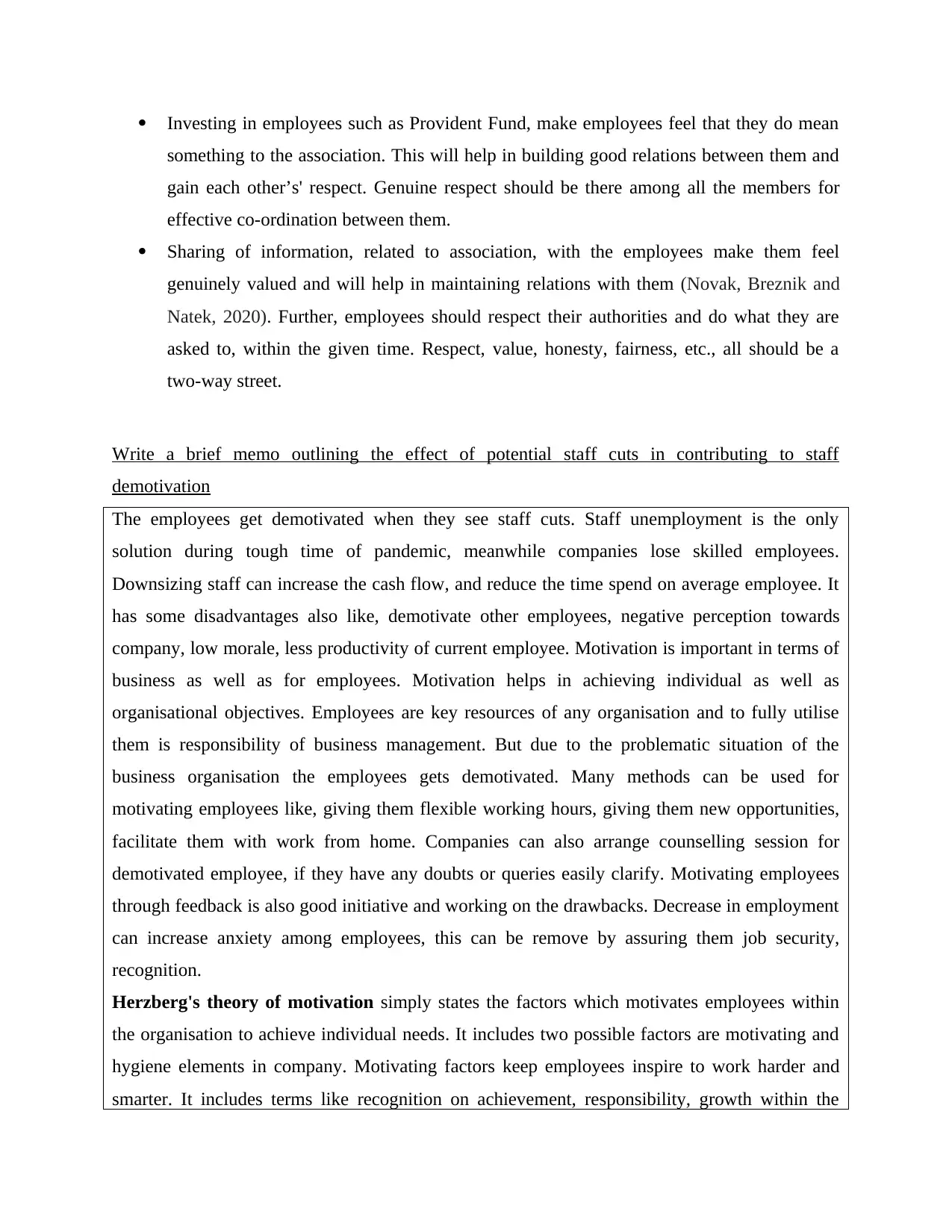
Investing in employees such as Provident Fund, make employees feel that they do mean
something to the association. This will help in building good relations between them and
gain each other’s' respect. Genuine respect should be there among all the members for
effective co-ordination between them.
Sharing of information, related to association, with the employees make them feel
genuinely valued and will help in maintaining relations with them (Novak, Breznik and
Natek, 2020). Further, employees should respect their authorities and do what they are
asked to, within the given time. Respect, value, honesty, fairness, etc., all should be a
two-way street.
Write a brief memo outlining the effect of potential staff cuts in contributing to staff
demotivation
The employees get demotivated when they see staff cuts. Staff unemployment is the only
solution during tough time of pandemic, meanwhile companies lose skilled employees.
Downsizing staff can increase the cash flow, and reduce the time spend on average employee. It
has some disadvantages also like, demotivate other employees, negative perception towards
company, low morale, less productivity of current employee. Motivation is important in terms of
business as well as for employees. Motivation helps in achieving individual as well as
organisational objectives. Employees are key resources of any organisation and to fully utilise
them is responsibility of business management. But due to the problematic situation of the
business organisation the employees gets demotivated. Many methods can be used for
motivating employees like, giving them flexible working hours, giving them new opportunities,
facilitate them with work from home. Companies can also arrange counselling session for
demotivated employee, if they have any doubts or queries easily clarify. Motivating employees
through feedback is also good initiative and working on the drawbacks. Decrease in employment
can increase anxiety among employees, this can be remove by assuring them job security,
recognition.
Herzberg's theory of motivation simply states the factors which motivates employees within
the organisation to achieve individual needs. It includes two possible factors are motivating and
hygiene elements in company. Motivating factors keep employees inspire to work harder and
smarter. It includes terms like recognition on achievement, responsibility, growth within the
something to the association. This will help in building good relations between them and
gain each other’s' respect. Genuine respect should be there among all the members for
effective co-ordination between them.
Sharing of information, related to association, with the employees make them feel
genuinely valued and will help in maintaining relations with them (Novak, Breznik and
Natek, 2020). Further, employees should respect their authorities and do what they are
asked to, within the given time. Respect, value, honesty, fairness, etc., all should be a
two-way street.
Write a brief memo outlining the effect of potential staff cuts in contributing to staff
demotivation
The employees get demotivated when they see staff cuts. Staff unemployment is the only
solution during tough time of pandemic, meanwhile companies lose skilled employees.
Downsizing staff can increase the cash flow, and reduce the time spend on average employee. It
has some disadvantages also like, demotivate other employees, negative perception towards
company, low morale, less productivity of current employee. Motivation is important in terms of
business as well as for employees. Motivation helps in achieving individual as well as
organisational objectives. Employees are key resources of any organisation and to fully utilise
them is responsibility of business management. But due to the problematic situation of the
business organisation the employees gets demotivated. Many methods can be used for
motivating employees like, giving them flexible working hours, giving them new opportunities,
facilitate them with work from home. Companies can also arrange counselling session for
demotivated employee, if they have any doubts or queries easily clarify. Motivating employees
through feedback is also good initiative and working on the drawbacks. Decrease in employment
can increase anxiety among employees, this can be remove by assuring them job security,
recognition.
Herzberg's theory of motivation simply states the factors which motivates employees within
the organisation to achieve individual needs. It includes two possible factors are motivating and
hygiene elements in company. Motivating factors keep employees inspire to work harder and
smarter. It includes terms like recognition on achievement, responsibility, growth within the
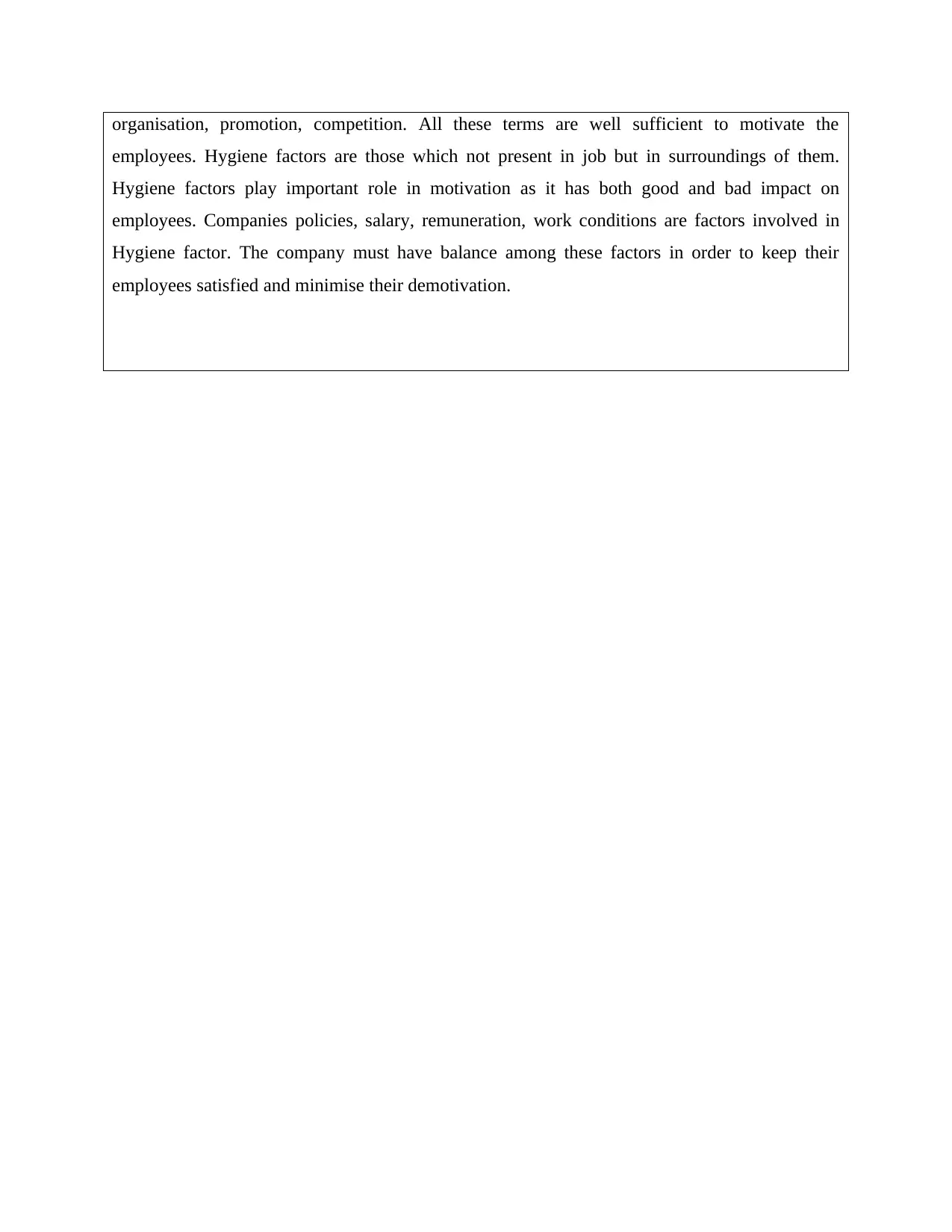
organisation, promotion, competition. All these terms are well sufficient to motivate the
employees. Hygiene factors are those which not present in job but in surroundings of them.
Hygiene factors play important role in motivation as it has both good and bad impact on
employees. Companies policies, salary, remuneration, work conditions are factors involved in
Hygiene factor. The company must have balance among these factors in order to keep their
employees satisfied and minimise their demotivation.
employees. Hygiene factors are those which not present in job but in surroundings of them.
Hygiene factors play important role in motivation as it has both good and bad impact on
employees. Companies policies, salary, remuneration, work conditions are factors involved in
Hygiene factor. The company must have balance among these factors in order to keep their
employees satisfied and minimise their demotivation.
Paraphrase This Document
Need a fresh take? Get an instant paraphrase of this document with our AI Paraphraser
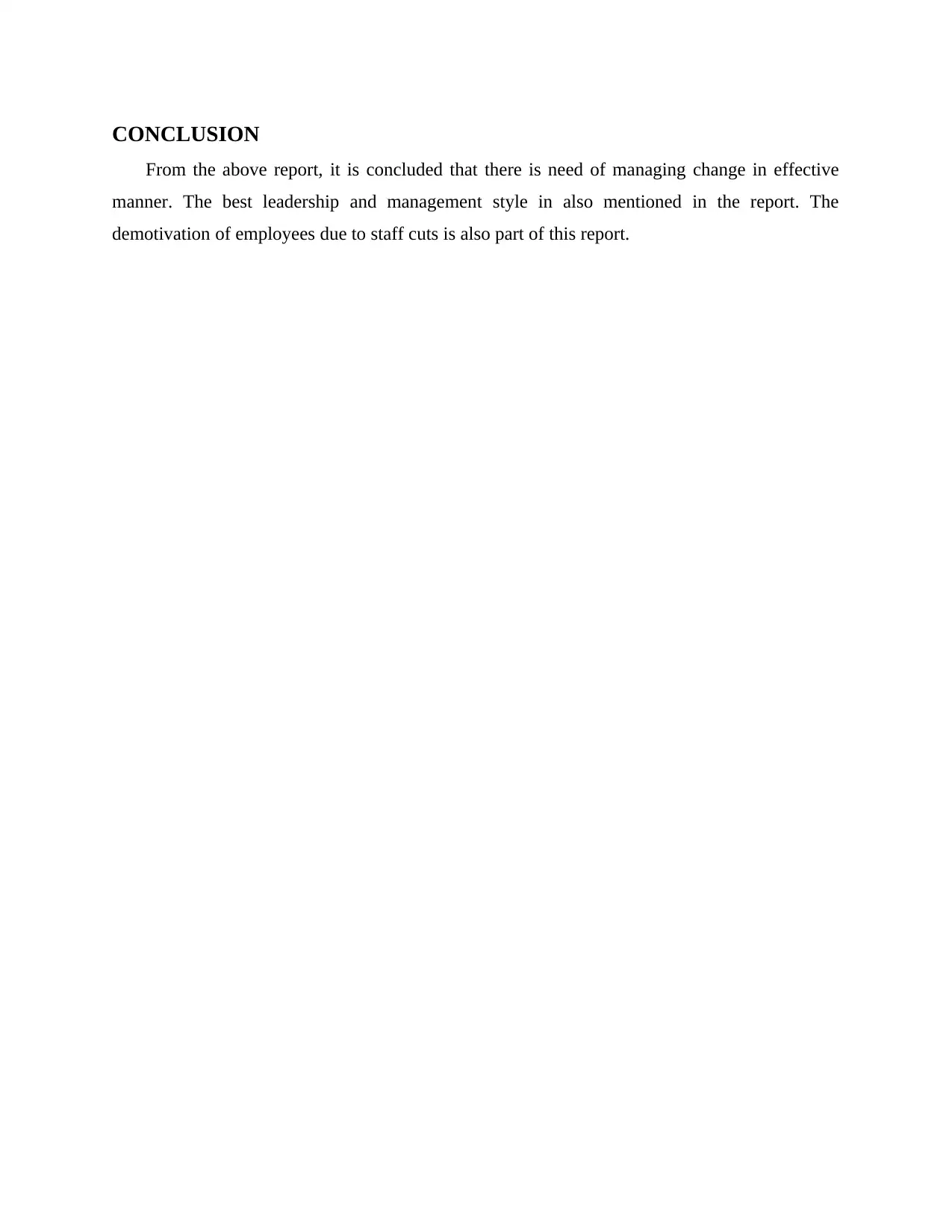
CONCLUSION
From the above report, it is concluded that there is need of managing change in effective
manner. The best leadership and management style in also mentioned in the report. The
demotivation of employees due to staff cuts is also part of this report.
From the above report, it is concluded that there is need of managing change in effective
manner. The best leadership and management style in also mentioned in the report. The
demotivation of employees due to staff cuts is also part of this report.
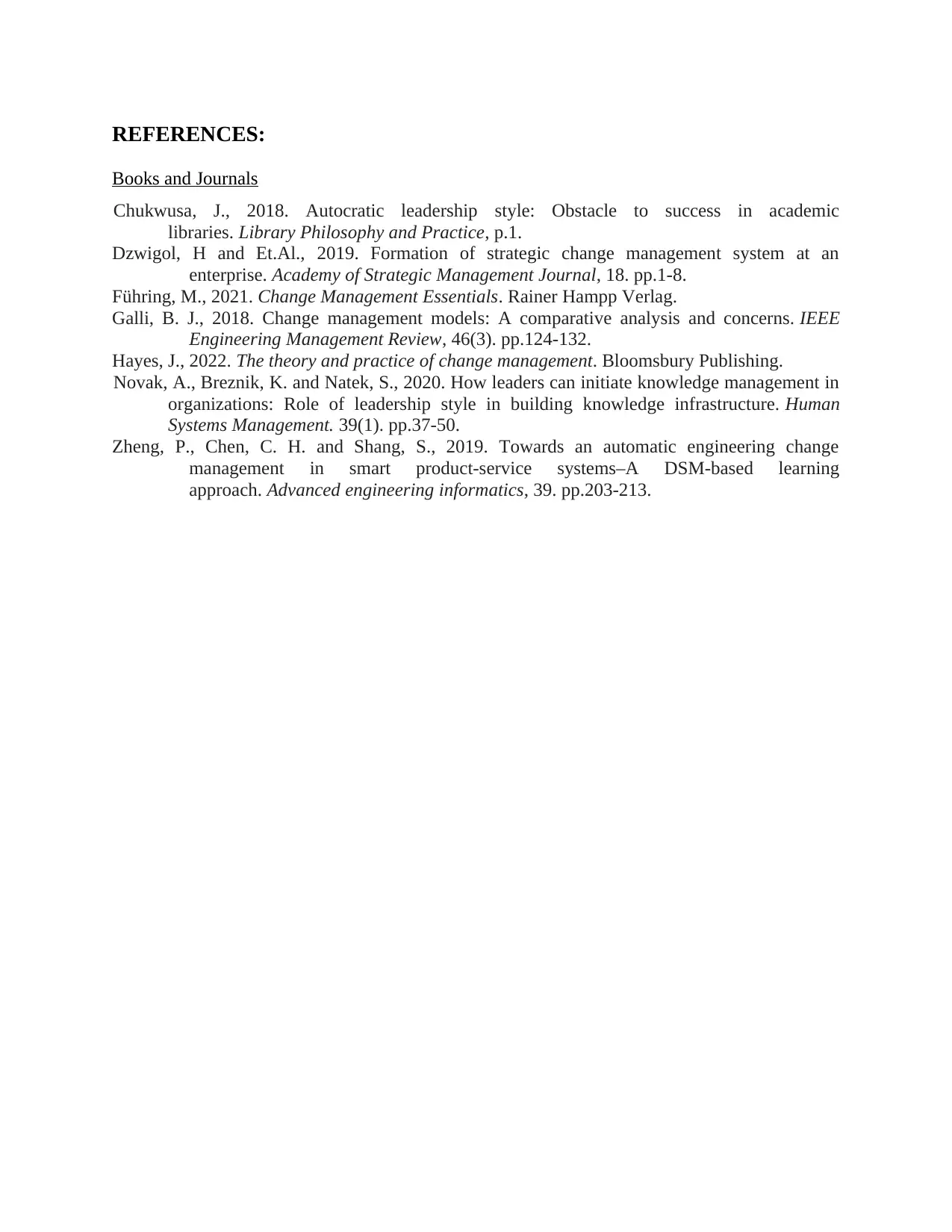
REFERENCES:
Books and Journals
Chukwusa, J., 2018. Autocratic leadership style: Obstacle to success in academic
libraries. Library Philosophy and Practice, p.1.
Dzwigol, H and Et.Al., 2019. Formation of strategic change management system at an
enterprise. Academy of Strategic Management Journal, 18. pp.1-8.
Führing, M., 2021. Change Management Essentials. Rainer Hampp Verlag.
Galli, B. J., 2018. Change management models: A comparative analysis and concerns. IEEE
Engineering Management Review, 46(3). pp.124-132.
Hayes, J., 2022. The theory and practice of change management. Bloomsbury Publishing.
Novak, A., Breznik, K. and Natek, S., 2020. How leaders can initiate knowledge management in
organizations: Role of leadership style in building knowledge infrastructure. Human
Systems Management. 39(1). pp.37-50.
Zheng, P., Chen, C. H. and Shang, S., 2019. Towards an automatic engineering change
management in smart product-service systems–A DSM-based learning
approach. Advanced engineering informatics, 39. pp.203-213.
Books and Journals
Chukwusa, J., 2018. Autocratic leadership style: Obstacle to success in academic
libraries. Library Philosophy and Practice, p.1.
Dzwigol, H and Et.Al., 2019. Formation of strategic change management system at an
enterprise. Academy of Strategic Management Journal, 18. pp.1-8.
Führing, M., 2021. Change Management Essentials. Rainer Hampp Verlag.
Galli, B. J., 2018. Change management models: A comparative analysis and concerns. IEEE
Engineering Management Review, 46(3). pp.124-132.
Hayes, J., 2022. The theory and practice of change management. Bloomsbury Publishing.
Novak, A., Breznik, K. and Natek, S., 2020. How leaders can initiate knowledge management in
organizations: Role of leadership style in building knowledge infrastructure. Human
Systems Management. 39(1). pp.37-50.
Zheng, P., Chen, C. H. and Shang, S., 2019. Towards an automatic engineering change
management in smart product-service systems–A DSM-based learning
approach. Advanced engineering informatics, 39. pp.203-213.
1 out of 9
Related Documents
Your All-in-One AI-Powered Toolkit for Academic Success.
+13062052269
info@desklib.com
Available 24*7 on WhatsApp / Email
![[object Object]](/_next/static/media/star-bottom.7253800d.svg)
Unlock your academic potential
© 2024 | Zucol Services PVT LTD | All rights reserved.





